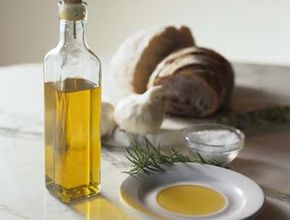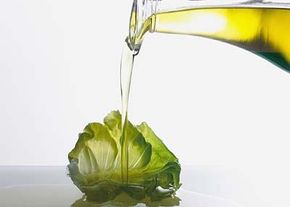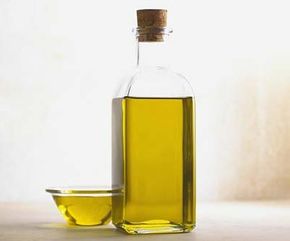Rich, beautiful, and fragrant, olive oil is much like wine -- taste is a matter of personal preference. The many variables that go into the production of olive oil yield dramatic differences in color, aroma, and flavor. And several names are used to differentiate all of these versions, which you'll learn about here.
The following factors impact the taste of olive oil:
- Variety of olive used
- Location and soil conditions where the olives were grown
- Environmental factors and weather during the growing season
- Olive ripeness
- Timing of the harvest
- Harvesting method
- Length of time between the harvest and pressing
- Pressing technique
- Packaging and storage methods
Olive oils are graded by production method, acidity content, and flavor. The International Olive Oil Council (IOOC) sets quality standards that most olive-oil-producing countries use, but the United States does not legally recognize these benchmarks. Instead, the U.S. Department of Agriculture uses a different system that was set up before the IOOC existed. However, American olive growers and oil importers are encouraging the USDA to adopt standards similar to those of the IOOC.
Where in the World?
When buying olive oil, you'll see varieties from all over the globe. Most of the world's supply is produced from olives grown in Spain, Italy, and Greece, but other areas, including France and California, are in on the fun, too. Here's what you need to know about olive oil and geography:
- Spanish olive oil is typically golden yellow with a fruity, nutty flavor. Spain produces about 45 percent of the world's olive supply.
- Italian olive oil is often dark green and has an herbal aroma and a grassy flavor. Italy grows about 20 percent of the world's olives.
- Greek olive oil packs a strong flavor and aroma and tends to be green. Greece produces about 13 percent of the world's olive supply.
- French olive oil is typically pale in color and has a milder flavor than other varieties.
- Californian olive oil is light in color and flavor, with a bit of a fruity taste.
Olives from different countries are often blended together to produce an oil variety. Or, olives from diverse areas of one country may be combined. These bulk-blended oils are the most economical but are still high quality. On the other hand, some producers only use olives that are grown in a specific area of a country. These regional oils are usually known for their unique flavors.
Estate olive oils are the cream of the crop. Estate oils are produced using olives from a single olive farm. These olives are usually handpicked, then pressed and bottled right at the estate. Expect to get the best flavor out of these varieties, but also expect to pay more.
Making the Grades
There are three basic grades of edible olive oil, and several types within each grade. Extra virgin includes "premium extra virgin" and "extra virgin"; virgin comprises "fine virgin," "virgin," and "semifine virgin"; and olive oil includes what used to be called "pure olive oil" and "refined oil."
All types of extra-virgin and virgin oils are made from the first pressing of the olives, which removes about 90 percent of the olives' juice. Chemicals and high heat are not allowed in the production of extra-virgin or virgin oils -- no further processing or refining occurs after the pressing process. Neither extra-virgin nor virgin oils are allowed to contain any refined olive oil.
Virgin olive oils
At the head of the olive oil class sit the extra-virgins, followed closely by the virgins. The difference between two oils and where they rank in the following hierarchy may be just half a percentage point of acidity. However, that is all it takes to distinguish between a very good oil and a great oil.
"Premium extra-virgin olive oil" is nature's finest, thanks to its extremely low acidity (possibly as low as 0.225 percent). It is best suited for using uncooked in dishes where you can appreciate its exquisite aroma and flavor. Try it in salads, as a dip for bread, or as a condiment.
"Extra-virgin olive oil" has a fruity taste and may be pale yellow to bright green in color. In general, the deeper the color, the more flavor it yields. IOOC regulations say extra-virgin olive oil must have a superior flavor and contain no more than 0.8 percent acidity, but other regulators set the acidity cut-off point at 1 percent. As with the premium version, it is best to use extra-virgin olive oil uncooked in order to appreciate its flavor.
"Fine virgin olive oil" must have a "good" taste (as judged by IOOC standards) and an acidity level of no more than 1.5 percent. Fine virgin olive oil is less expensive than extra-virgin oil but is close in quality and is good uncooked.
"Virgin olive oil" must have a "good" taste, and its acidity must be 2 percent or less. Like other virgin oils, it cannot contain any refined oil. Virgin olive oil is good for cooking, but it also has enough flavor to be enjoyed uncooked.
"Semifine virgin olive oil" must have an acidity no higher than 3.3 percent. It is good for cooking but doesn't have enough flavor to be enjoyed uncooked.
Lower-quality oils
Some olive oil is further refined after the first pressing. These three types of oils can no longer bear the title "virgin."
When virgin oils are not fit for human consumption (because of poor flavor, an acidity level greater than 3.3 percent, or an unpleasant aroma), they are sent to a processing plant where they become "refined olive oils." There they undergo processing with agents that might include heat, chemicals, and/or filtration.
These refined olive oils become clear, odorless, and flavorless and have an acidity level of 0.3 percent or less, which gives them a long shelf life (refined olive oils' only real advantage). They are typically blended with virgin oils, used in cooking, or used for foods that are labeled "packed in olive oil."
The current "olive oil" category used to be called "pure olive oil." Today, oils in this classification are a blend of refined olive oil and a virgin olive oil. The virgin oil lends a little aroma and flavor to the final product, which can have an acidity level of no more than 1.5 percent. In most cases, oils in this category contain about 85 percent refined oil and 15 percent virgin or extra-virgin oil. Oils of the "olive oil" grade withstand heat well.
"Olive pomace oil" is made from the olive paste that is left in the centrifuge after the olives are pressed and the oil-water mixture is extracted. Olive pomace oil can be treated with heat and chemicals to extract additional oil (about 10 percent of the original amount of oil in the olives). Its acidity cannot exceed 1.5 percent.
Virgin oil may be added to pomace oil for color and flavor. Olive pomace oil is edible, but it may not carry the name "olive oil." This oil is most often used commercially and is rarely seen on the grocer's shelf.
Other oils
Sometimes, cooks don't need the full flavor of olive oil, or they need a little extra taste added. Oil producers have responded to these needs by creating lite olive oil and flavored oils.
"Lite olive oil" is also called "light" or "mild" oil. These oils have undergone an extremely fine filtration process (without the use of heat or chemicals) to remove most of the natural color, aroma, and flavor. This makes them suitable for cooking or baking in recipes in which a fruity olive flavor isn't needed. The terms "lite," "light," and "mild" can be used along with "extra virgin olive oil," "virgin olive oil," and "olive oil."
In this case, "lite" or "light" do not refer to fat content. These oils contain the same amount of fat and calories as any other olive oil (about 13 grams of fat and 120 calories per tablespoon). The classifications instead refer to the oil's lighter color and flavor.
Do you want oil with more flavor rather than less? Some manufacturers make high-quality flavored olive oils by adding sweet or savory ingredients, such as spices, herbs, vegetables, or citrus peel, to extra-virgin oils during the pressing process. Lower-quality flavored oils have these ingredients added after pressing.
Commercially prepared flavored oils are usually safe to keep and use for a long period of time, but homemade ones are not. If you create your own homemade flavored oils, make only small amounts that you can use within several days, and always store them in the refrigerator to prevent the growth of potentially harmful bacteria. The oil itself does not support bacterial growth, but the moisture and nutrients in fresh herbs, garlic, dried tomatoes, or citrus peels do.
Color Considerations
Green olive oils come from unripe olives and impart a slightly bitter, pungent flavor. Emerald-tinged oils have fruity, grassy, and peppery flavors that dominate the foods in which you use them. These oils are great with neutral-flavored foods that allow their bold flavors to shine. You can pair green olive oils with strongly flavored foods as long as they complement the oils' pungent tastes.
Olive oils that glimmer with a golden color are made from ripe olives. Olives turn from green to bluish-purple to black as they ripen. Oils made from ripe olives have a milder, smoother, somewhat buttery taste without bitterness. These oils are perfect for foods with subtle flavors because the gentle taste of a ripe olive oil won't overshadow mildly flavored foods.
Organic Olive Oil
All plants have natural enemies, and olive trees are no different. Olives are susceptible to a pest known as the olive fly, which lives inside the olive and makes a feast of the fruit. Fungus is another adversary of olives, although olive flies are a bigger threat.
Growers use pesticides, fungicides, and herbicides to protect their crops when necessary. If you'd like to avoid these chemicals, buy organic olive oil.
In the United States there are strict guidelines governing the use of the term "organic" on labels. If the label says "USDA Certified Organic," the producer has proven to the U.S. Department of Agriculture that the oil is made with olives that were grown without chemicals, among other requirements. The regulations apply whether the olives are grown and bottled in the United States or imported from other countries.
When you pick the type you like, it can last for months properly stored. On the next page you'll learn how to prevent a breakdown of the nutrients in olive oil.
To learn more about the topics covered in this article, check out the following links:




